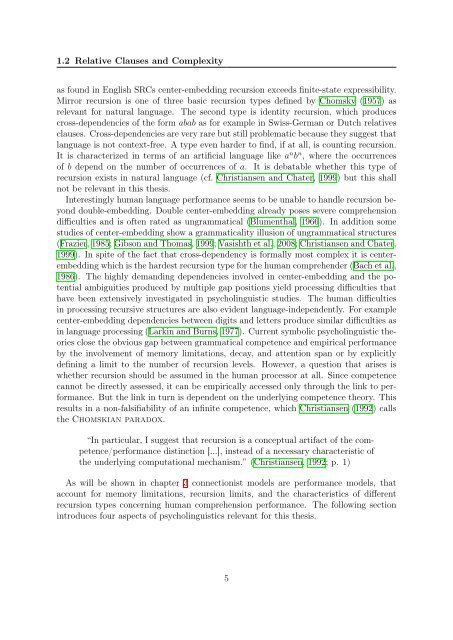Connectionist Modeling of Experience-based Effects in Sentence ...
Connectionist Modeling of Experience-based Effects in Sentence ...
Connectionist Modeling of Experience-based Effects in Sentence ...
Create successful ePaper yourself
Turn your PDF publications into a flip-book with our unique Google optimized e-Paper software.
1.2 Relative Clauses and Complexity<br />
as found <strong>in</strong> English SRCs center-embedd<strong>in</strong>g recursion exceeds f<strong>in</strong>ite-state expressibility.<br />
Mirror recursion is one <strong>of</strong> three basic recursion types def<strong>in</strong>ed by Chomsky (1957) as<br />
relevant for natural language. The second type is identity recursion, which produces<br />
cross-dependencies <strong>of</strong> the form abab as for example <strong>in</strong> Swiss-German or Dutch relatives<br />
clauses. Cross-dependencies are very rare but still problematic because they suggest that<br />
language is not context-free. A type even harder to f<strong>in</strong>d, if at all, is count<strong>in</strong>g recursion.<br />
It is characterized <strong>in</strong> terms <strong>of</strong> an artificial language like a n b n , where the occurrences<br />
<strong>of</strong> b depend on the number <strong>of</strong> occurrences <strong>of</strong> a. It is debatable whether this type <strong>of</strong><br />
recursion exists <strong>in</strong> natural language (cf. Christiansen and Chater, 1999) but this shall<br />
not be relevant <strong>in</strong> this thesis.<br />
Interest<strong>in</strong>gly human language performance seems to be unable to handle recursion beyond<br />
double-embedd<strong>in</strong>g. Double center-embedd<strong>in</strong>g already poses severe comprehension<br />
difficulties and is <strong>of</strong>ten rated as ungrammatical (Blumenthal, 1966). In addition some<br />
studies <strong>of</strong> center-embedd<strong>in</strong>g show a grammaticality illusion <strong>of</strong> ungrammatical structures<br />
(Frazier, 1985; Gibson and Thomas, 1999; Vasishth et al., 2008; Christiansen and Chater,<br />
1999). In spite <strong>of</strong> the fact that cross-dependency is formally most complex it is centerembedd<strong>in</strong>g<br />
which is the hardest recursion type for the human comprehender (Bach et al.,<br />
1986). The highly demand<strong>in</strong>g dependencies <strong>in</strong>volved <strong>in</strong> center-embedd<strong>in</strong>g and the potential<br />
ambiguities produced by multiple gap positions yield process<strong>in</strong>g difficulties that<br />
have been extensively <strong>in</strong>vestigated <strong>in</strong> psychol<strong>in</strong>guistic studies. The human difficulties<br />
<strong>in</strong> process<strong>in</strong>g recursive structures are also evident language-<strong>in</strong>dependently. For example<br />
center-embedd<strong>in</strong>g dependencies between digits and letters produce similar difficulties as<br />
<strong>in</strong> language process<strong>in</strong>g (Lark<strong>in</strong> and Burns, 1977). Current symbolic psychol<strong>in</strong>guistic theories<br />
close the obvious gap between grammatical competence and empirical performance<br />
by the <strong>in</strong>volvement <strong>of</strong> memory limitations, decay, and attention span or by explicitly<br />
def<strong>in</strong><strong>in</strong>g a limit to the number <strong>of</strong> recursion levels. However, a question that arises is<br />
whether recursion should be assumed <strong>in</strong> the human processor at all. S<strong>in</strong>ce competence<br />
cannot be directly assessed, it can be empirically accessed only through the l<strong>in</strong>k to performance.<br />
But the l<strong>in</strong>k <strong>in</strong> turn is dependent on the underly<strong>in</strong>g competence theory. This<br />
results <strong>in</strong> a non-falsifiability <strong>of</strong> an <strong>in</strong>f<strong>in</strong>ite competence, which Christiansen (1992) calls<br />
the Chomskian paradox.<br />
“In particular, I suggest that recursion is a conceptual artifact <strong>of</strong> the competence/performance<br />
dist<strong>in</strong>ction [...], <strong>in</strong>stead <strong>of</strong> a necessary characteristic <strong>of</strong><br />
the underly<strong>in</strong>g computational mechanism.” (Christiansen, 1992; p. 1)<br />
As will be shown <strong>in</strong> chapter 3 connectionist models are performance models, that<br />
account for memory limitations, recursion limits, and the characteristics <strong>of</strong> different<br />
recursion types concern<strong>in</strong>g human comprehension performance. The follow<strong>in</strong>g section<br />
<strong>in</strong>troduces four aspects <strong>of</strong> psychol<strong>in</strong>guistics relevant for this thesis.<br />
5
















